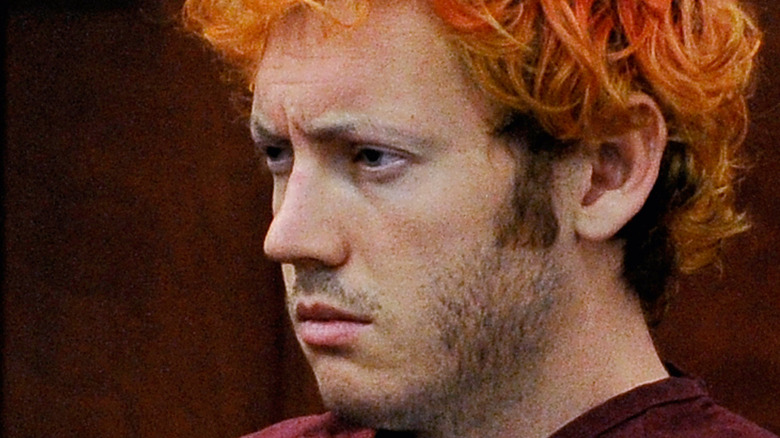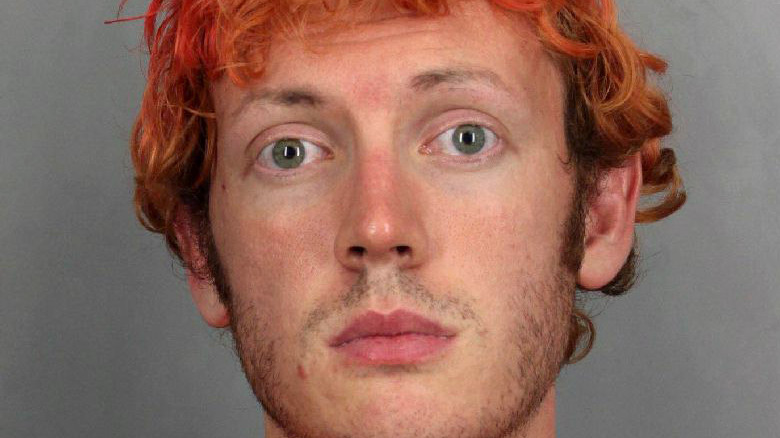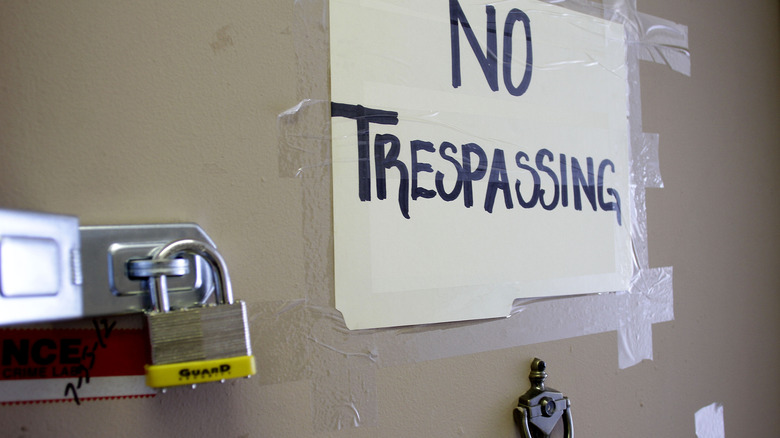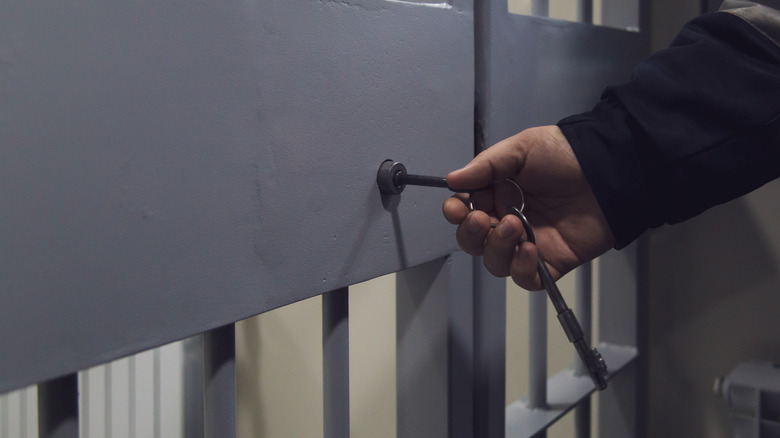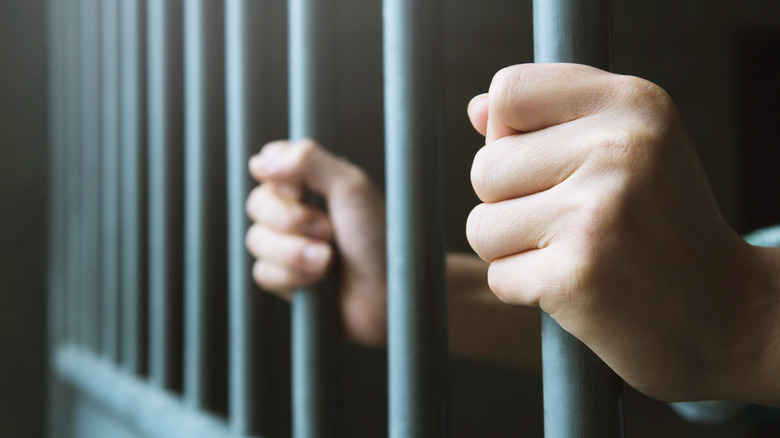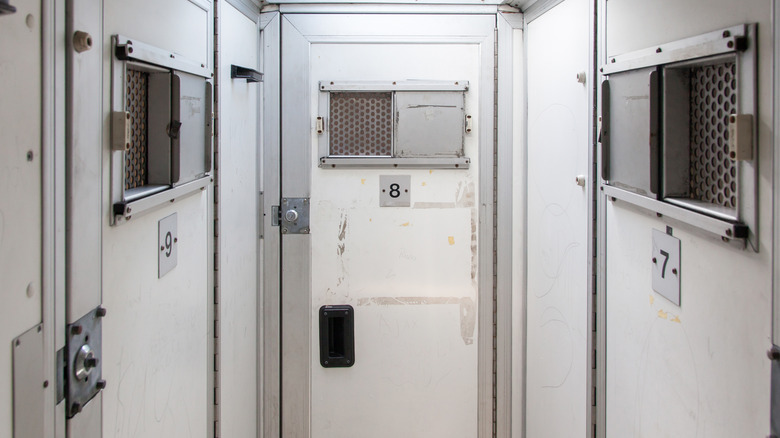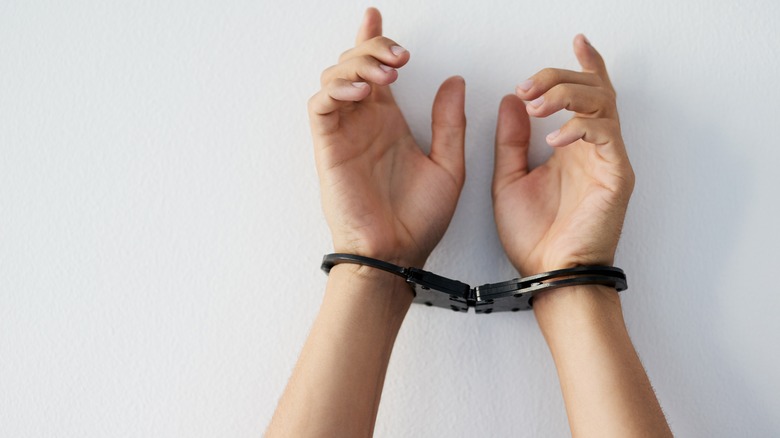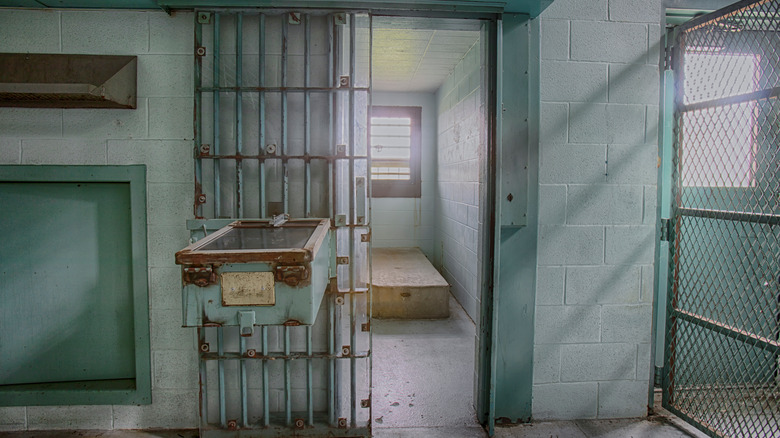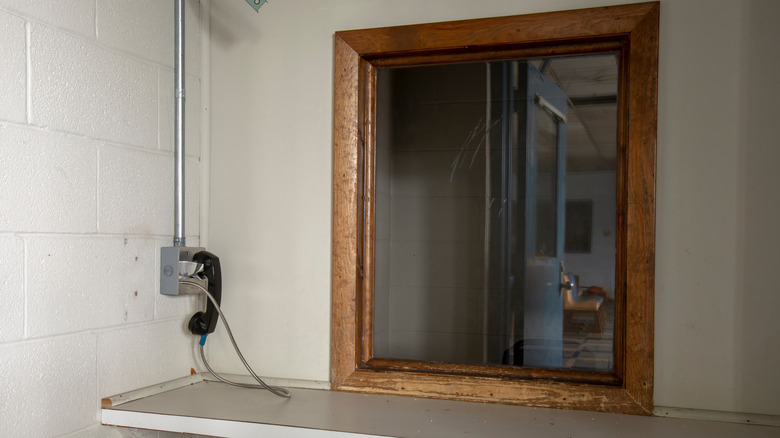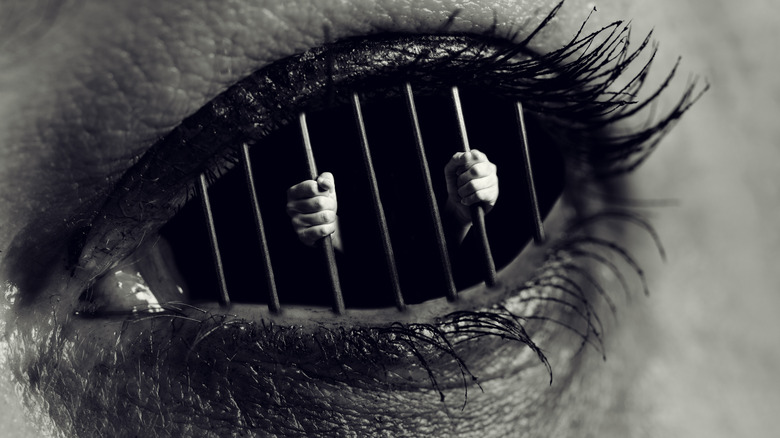What James Holmes' Life In Prison Is Really Like
For dozens of people, July 20, 2012, seemed like it was going to be like any other ordinary day — except, they were going to go see the new Batman movie, "The Dark Knight Rises." But by the end of the day, countless lives would be horrendously and forever changed after one man — James Holmes — donned body armor and a gas mask, stepped into a sold-out theater, and started shooting. Holmes killed 12 and injured 58 in what would be one of the worst mass shootings in U.S. history. (According to CNN, 70 were injured.)
The New York Times says that it didn't take long after the shooting for people to come forward to give accounts of their encounters with him: Some described him as shy but amiable, selectively communicative, and one shared a text where he self-described himself as "bad news." That was two weeks before the shooting, and what emerged was a worrisome picture of someone descending to the point of deadly violence.
The trial ended long ago, and the news cycle moved on — but what about Holmes? Where is he now, and what kind of life has he found waiting for him behind bars?
If you have been impacted by incidents of mass violence, or are experiencing emotional distress related to incidents of mass violence, you can call or text Disaster Distress Helpline at 1-800-985-5990 for support.
What happened while he was being held before and during his trial?
When James Holmes was in custody awaiting — and during — his trial, Colorado Public Radio says that one of the biggest concerns for District Judge Carlos Samour was preventing leaked and prejudicial information. That means there's a lot that just wasn't made public about that time, but there are some things that have come out since the end of the trial.
In 2015 — just before sentencing — father Robert Holmes (pictured, with mother Arlene) took the stand to talk about the son that he knew. It was a son that, says CNN, he hadn't seen in a long time: After a few visits from his parents, James refused to allow them to visit him in jail.
James did, however, spend hours talking with court-appointed mental health professionals, including psychiatrist William H. Reid. During the interview, Reid debunked the idea that Holmes identified with Batman's Joker, and that a romantic breakup had been a major trigger. He also determined that Holmes was probably not a threat to other prisoners, in spite of an eerie exchange. When asked if he was planning on killing again, Holmes answered in the affirmative — and when a follow-up question was asked to determine if corrections officers should be aware of that, he answered, "Um, I'd say so, yeah."
The sentencing
The cornerstone of the case was James Holmes's mental state, and whether or not he had the ability to understand that what he had done was wrong. According to CNN, Holmes revealed that he believed that every life he took added a "life point" to his own value — and that if he amassed enough value, then he would no longer feel as though he needed to commit suicide.
Holmes was facing 166 criminal charges, and given that most of them were attempting or alleging murder, it was more than enough for the death penalty — and that's what prosecutors were going for. They nearly got it, but one lone juror held out with a "no."
By the time Holmes's sentencing hearing wrapped up, more than three years had passed since the shooting. He dodged the death penalty and was given what was believed to be the fourth-longest sentence ever handed down in the U.S. — a life sentence for each of the 12 people he had killed, plus another 3,318 years for those who had been injured, as well as for the explosives he had wired in his apartment (via CNN).
If you or anyone you know is having suicidal thoughts, please call the National Suicide Prevention Lifeline by dialing 988 or by calling 1-800-273-TALK (8255).
There were accusations of outrageous special treatment
James Holmes nearly got the death penalty, and if he had, he would have been sent to death row — located at the Sterling Correctional Facility. Instead, it was off to the Colorado State Penitentiary, and it was just about a month into his confinement that Westword heard rumblings about how he was being treated unfairly well.
It was a fellow inmate who wrote to the publication about Holmes, saying: "Holmes has been placed in a sixteen-man pod all by himself. He gets out of his cell two hours in the a.m. and two hours in the p.m. Whenever he is out of his cell, a guard sits in a chair in front of the pod and watches him. I thought you might be interested to know the amount of resources DOC is expending on this dude."
DOC spokesperson Adrienne Jacobson confirmed that yes, he had a whole section to himself, but said that it was partially because they were under capacity at the time. In spite of accusations of "mollycoddling," Jacobson said that all of his time spent out of the cell — and other unspecified privileges — were given as a part of his close-custody status, and were afforded to all prisoners of the same classification.
He was attacked in prison
After James Holmes was sentenced to thousands of years behind bars for the murder and setting explosives at his apartment (pictured), he was moved to Canon City's Colorado State Penitentiary. According to what Colorado Prisons Director Steve Hager told ABC News, it had been decided that Holmes was to be isolated from every other inmate, and only have interactions with prison staff. It was still a very early measure: Holmes had only been there five weeks, and prison officials were still working on whether or not his infamy warranted holding him in protective custody indefinitely.
Then, on Oct. 8, 2015, Holmes was leaving a meeting with his case manager when an opened door left him face-to-face with another inmate named Mark Daniels. Daniels — who had been convicted of car theft and forgery — lunged for Holmes. The confrontation was broken up by officers fairly quickly, with at least one getting hit in the process, and a follow-up investigation cited a dead battery in a radio as the source of the breakdown in communication.
Daniels later wrote a letter to a Denver newspaper, saying: "I'm so sorry I couldn't wipe him out and sent [sic] him packing to Satan's lake of fire. It was just impossible to do by myself with so many cops. I did get him six or seven good ones ... He was very scared." Ex-corrections official Bob Hood explained that it wasn't entirely surprising: [Holmes is] always going to be a target."
There were claims that corrections officers were in on the attack
After the 2015 assault on James Holmes, a few things happened that shed some light on just how dangerous his prison time could turn out to be. Attacker Mark Daniels was moved to another area of the prison and punished with a loss of privileges, but ABC News says that once word of the attack leaked, Daniels received letters of congratulations and support, money put into his commissary account, and more donations through a GoFundMe set up by his mother. There were also rumors of a website startup called "James' Jailhouse Justice," suggesting that it wasn't over.
Then, Daniels made some serious allegations via his father, Tim Daniels. When CBS News spoke with him, he said that there were claims that the prison's guards had been in on the attack.
Steve Hager, the Colorado Department of Corrections' director of prisons, later said that there was absolutely no basis for those claims. He also added that no one would be disciplined, and, strangely, also acknowledged that there was no video or photographic record of the incident whatsoever.
The attack didn't mean a reevaluation of security
What happened after the attack on James Holmes is a little hazy. ABC News attempted to find out just what was being done to prevent future attacks, and said that due to the sensitive nature of the specialized security needed around Holmes, that was pretty much all they were going to say. Holmes was going to continue to reside where he had been, in an area of the prison called the Close Custody Management Control Unit. (The Colorado State Penitentiary was built with several custody levels, including a medium security area, maximum security, a temporary general population area, and the Management Control Unit.)
It's worth noting, however, that in the aftermath of the attack, Colorado Department of Corrections spokesperson Adrienne Jacobson told The Denver Post (via Corrections 1) that the prison would not be reevaluating their security measures, either on an overall basis, or specifically for Holmes. At the time of the attack, Holmes was the only prisoner housed in his entire cell black, and for four hours every day, he was transferred to a day hall (via Corrections 1).
He spent some time in a specialized prison setting
In Dec. 2015, Reuters reported that James Holmes had been moved to a new facility. This was the San Carlos Correctional Facility in Pueblo, and according to Department of Corrections spokesperson Adrienne Jacobson: "He is now in more of a general population setting. It's a normal progression move."
Details on what it was like for Holmes at this second stop are scarce, but there are some things that can be gleaned from the prison itself. San Carlos is a fairly small prison with a capacity of about 255 inmates, and that's because they provide more specialized care. The facility houses mostly inmates with specific requirements and mental health issues, which is in line with Holmes's diagnosis of schizotypal personality disorder (via CNN). The Cleveland Clinic says that schizotypal personality disorder is characterized by "intense discomfort with close relationships and social interactions," along with eccentric and problematic behaviors, and a belief that magical forces influence their life. They typically have no idea their behavior is considered abnormal, and it can develop into schizophrenia.
While it's not clear what programs Holmes was involved in, San Carlos provides things like group and individual therapy, educational programs, recreational therapy, and was designed to prepare individuals for reintroduction into a larger community.
If you or someone you know needs help with mental health, please contact the Crisis Text Line by texting HOME to 741741, call the National Alliance on Mental Illness helpline at 1-800-950-NAMI (6264), or visit the National Institute of Mental Health website.
He was transferred out of Colorado, and no one knew where
After James Holmes was transferred to the mental health-specific facility at San Carlos, Reuters reported that Department of Corrections officials said that probably wasn't going to be his last stop — and it wasn't. Holmes then just sort of dropped off the radar. Not long after he was moved to San Carlos, he was moved again — and his location was kept secret for almost two years. According to The Washington Post, the only thing that was known was that he was somewhere outside of Colorado — and there was a massive push from survivors, families, and prosecutors to know where he had been taken.
It wasn't until Sept. 2017 that it was revealed that he had been transferred halfway across the country to a high-security prison in Pennsylvania. Colorado officials said that attempts to keep him in-state had failed, because he was still considered a high-risk prisoner and in need of a facility with particular (but unspecified) security measures in place. So, he had been transferred up to a federal-level facility at Allenwood.
The silence over his location brought up a lot of questions, which haven't been answered. Law enforcement officials chalked the secrecy up to security concerns, but as The Washington Post points out, other high-profile inmates haven't been subjected to the same levels of secrecy in regards to their whereabouts. That led to speculation that there was more going on behind the scenes than most knew, but for now, that's still not public information.
He's being held in solitary confinement
Back in 2016, CBS News was still reporting that it was unknown just where James Holmes had been transferred to. They did, however, know a little bit about what his daily life was like, thanks to a report issued by the attorney general's office. The report, says The Denver Post, was issued in response to the case's prosecutors, who demanded some serious answers amid claims that he was receiving special treatment at his mystery location — treatment that definitely wasn't a part of his 3,000-plus year sentence.
Perhaps the most significant confirmation made was that, yes, Holmes spent his days in solitary confinement. The document revealed that for 23 hours a day, he was confined to his cell, and the only time he's allowed to watch television is the one hour a day he is allowed out. They also confirmed that during that hour, he has no contact with other inmates, and he isn't allowed to go outside.
He also isn't allowed access to exercise equipment, which is a pretty standard right for most inmates. Instead, the report says that he is only permitted to do calisthenics, a form of exercise that requires no equipment.
There are strict limits on what he has access to — and who has access to him
There are, of course, a lot of restrictions placed on mail — physical and electronic — for inmates. According to the inmate handbook issued by USP Allenwood, access to mail and the mailroom is considered a pretty basic right — along with communication with the outside. However, according to the 2016 document released to prosecutors detailing James Holmes's treatment in the then-undisclosed location (via The Denver Post), it seems as though it may be a little different for him.
The Department of Corrections confirmed that not only did Holmes have no access to email or the internet, but they also added that they had forwarded no actual, physical mail to him, either. (Wording leaves it vague as to whether he hadn't received any, or wasn't allowed any.)
Holmes also has limits placed on physical interaction, too: Although serial killers like Richard Ramirez might have infamously found love while behind bars, that's not going to happen for Holmes — he isn't allowed to marry, and he isn't permitted conjugal visits.
What unofficial information can we discern?
It's now public information that James Holmes is an inmate at USP Allenwood. While information on his day-to-day routine is scarce, the inmate handbook — given to each incoming inmate on their arrival — is available online. What does it suggest about Holmes's life there?
As Holmes is in solitary confinement, much of the manual probably doesn't apply. There are, however, mentions of services and rules for those in "Special Housing," which likely include solitary confinement. These include things like a daily consultation with a member of the prison's clinical/medical staff, and a full physical examination once a year. (Which, interestingly, includes an annual screening for tuberculosis.)
It's also worth noting that there is a list of rights afforded to inmates who are confined in Special Housing, which is typically done in extenuating circumstances. These include things like a right to fresh air and outdoor time, correspondence with friends and family, enrollment in educational programs, and confidential access to information about the inmate's conviction. Given that some of those have been said to be off the table for Holmes, it's possible to say that he might be getting non-standard treatment after all.
What is solitary confinement like?
It might not seem entirely surprising that James Holmes is in solitary confinement, apparently allowed minimal human contact a day. But according to CBS News, it is unusual. The state of Colorado was still involved in Holmes's transfer to and treatment in an out-of-state facility, and at the time of the 2016 report that was designed to allay fears of preferential treatment, the state rarely sanctioned solitary confinement. Why? Because of the 2013 murder of Colorado Department of Corrections Director Tom Clements.
Clements, says Prison Legal News, was killed by a former inmate named Evan Ebel. Ebel had served most of his eight years in solitary, and when he was released, he was found to have "a high level of paranoid and [is] extremely anxious." His father went on to explain, "I hardly recognize my son sometimes. We are creating mental illness. We are exacerbating mental illness."
Even before that, the American Psychological Association was studying the impact of long-term solitary confinement, like the conditions Holmes is housed in. They found the conditions severely damaging, with inmates reporting high instances of depression, hallucinations, insomnia, anxiety, paranoia, and panic attacks. Craig Haney, a psychology professor at the University of California, Santa Cruz, explains what's at the heart of it: "for some prisoners, solitary confinement precipitates a descent into madness ... They actually get to the point where they become frightened of other human beings."
If you or someone you know needs help with mental health, please contact the Crisis Text Line by texting HOME to 741741, call the National Alliance on Mental Illness helpline at 1-800-950-NAMI (6264), or visit the National Institute of Mental Health website.
